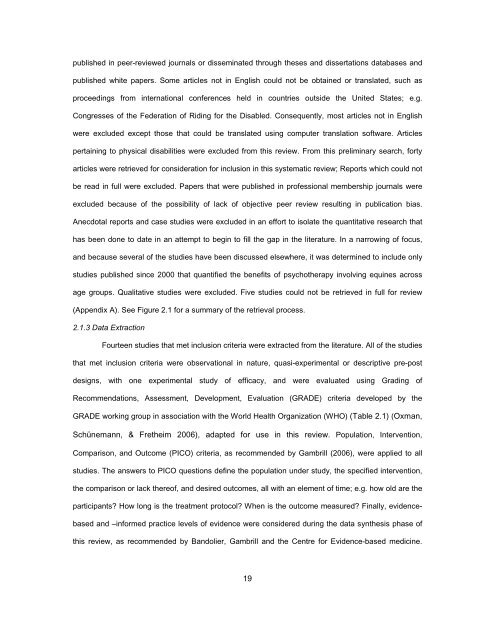A SYSTEMATIC REVIEW OF THE EFFECTS OF PSYCHOTHERAPY ...
A SYSTEMATIC REVIEW OF THE EFFECTS OF PSYCHOTHERAPY ...
A SYSTEMATIC REVIEW OF THE EFFECTS OF PSYCHOTHERAPY ...
You also want an ePaper? Increase the reach of your titles
YUMPU automatically turns print PDFs into web optimized ePapers that Google loves.
published in peer-reviewed journals or disseminated through theses and dissertations databases and<br />
published white papers. Some articles not in English could not be obtained or translated, such as<br />
proceedings from international conferences held in countries outside the United States; e.g.<br />
Congresses of the Federation of Riding for the Disabled. Consequently, most articles not in English<br />
were excluded except those that could be translated using computer translation software. Articles<br />
pertaining to physical disabilities were excluded from this review. From this preliminary search, forty<br />
articles were retrieved for consideration for inclusion in this systematic review; Reports which could not<br />
be read in full were excluded. Papers that were published in professional membership journals were<br />
excluded because of the possibility of lack of objective peer review resulting in publication bias.<br />
Anecdotal reports and case studies were excluded in an effort to isolate the quantitative research that<br />
has been done to date in an attempt to begin to fill the gap in the literature. In a narrowing of focus,<br />
and because several of the studies have been discussed elsewhere, it was determined to include only<br />
studies published since 2000 that quantified the benefits of psychotherapy involving equines across<br />
age groups. Qualitative studies were excluded. Five studies could not be retrieved in full for review<br />
(Appendix A). See Figure 2.1 for a summary of the retrieval process.<br />
2.1.3 Data Extraction<br />
Fourteen studies that met inclusion criteria were extracted from the literature. All of the studies<br />
that met inclusion criteria were observational in nature, quasi-experimental or descriptive pre-post<br />
designs, with one experimental study of efficacy, and were evaluated using Grading of<br />
Recommendations, Assessment, Development, Evaluation (GRADE) criteria developed by the<br />
GRADE working group in association with the World Health Organization (WHO) (Table 2.1) (Oxman,<br />
Schünemann, & Fretheim 2006), adapted for use in this review. Population, Intervention,<br />
Comparison, and Outcome (PICO) criteria, as recommended by Gambrill (2006), were applied to all<br />
studies. The answers to PICO questions define the population under study, the specified intervention,<br />
the comparison or lack thereof, and desired outcomes, all with an element of time; e.g. how old are the<br />
participants? How long is the treatment protocol? When is the outcome measured? Finally, evidencebased<br />
and –informed practice levels of evidence were considered during the data synthesis phase of<br />
this review, as recommended by Bandolier, Gambrill and the Centre for Evidence-based medicine.<br />
19
















